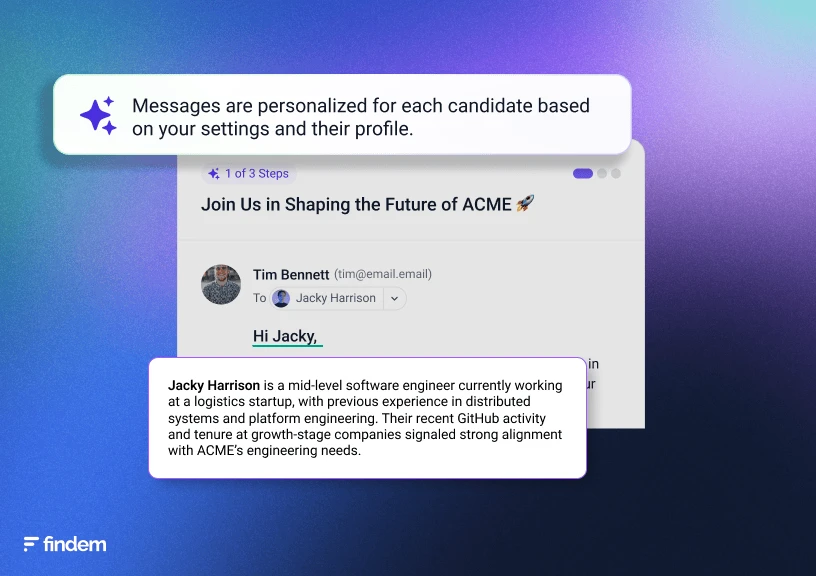.svg)

.svg)
Artificial intelligence has become a steady presence across HR, reshaping how people teams hire, develop, and retain talent.
As Gartner observes, “Organizations are increasingly embedding AI technology across the employee lifecycle, from recruitment and onboarding to learning and development and talent management.”
Still, many HR leaders remain uncertain about what AI can realistically do in practice. The technology conversation is loud, but the examples are often vague. What’s missing is clarity — where exactly AI adds value, what outcomes it delivers, and where it still requires human judgment.
This guide grounds the discussion in reality. It explores the most common AI use cases in HR, breaking down how each works, what benefits it offers, and what to watch for along the way.
Common use cases of AI in HR
Resume screening
How it works
Traditional resume screening is time-intensive and subjective. Machine learning models now take on the first pass, scanning resumes for skills, experience, and role fit. Over time, they learn from hiring outcomes, analyzing past data to improve accuracy.
Rather than filtering by keywords, modern systems evaluate patterns that correlate with success: depth of experience, relevant projects, or trajectory of responsibility.
Benefits
- Speeds up early-stage screening: Thousands of applications can be reviewed in minutes instead of days.
- Improves consistency: Each resume is evaluated using the same criteria, minimizing unconscious bias.
- Frees recruiters to focus on high-potential candidates: Human effort shifts from data entry to decision quality.
What to watch
Bias can reappear if the training data mirrors historical imbalances. Regular bias audits and diverse training sets are key.
Transparency also matters. According to HR Dive and ServiceNow, 90% of job seekers want companies to be upfront about AI’s role in recruiting and hiring.
Disclosure builds trust, especially when candidates know that a person still makes the final call.
AI for sourcing
How it works
Sourcing used to depend on manual searches and keyword filters. Today, AI models scour multiple databases, public profiles, and internal CRMs to identify qualified talent using attribute-based matching.
As Workday notes, “Traditional sourcing often skews toward active job seekers, but the best candidates are frequently already employed and not browsing job boards.” AI helps recruiters shift from reactive to proactive — finding strong, relevant candidates who may never apply on their own.
Benefits
- Builds deeper, more diverse candidate pools: AI uncovers talent from alumni networks, referrals, and passive sources.
- Saves recruiter time: Automated search eliminates repetitive boolean queries.
- Enhances quality: Finds candidates who match on outcomes and capabilities, not just keywords or titles.
What to watch
Data must be current and verified. Incomplete or outdated profiles can lead to poor matches. Automation also has a social cost: outreach that feels impersonal can turn candidates away.
Responsible use combines automation with human empathy. For example, leveraging AI to find candidates, but relying on people to engage them.
AI for talent acquisition
How it works
AI now supports nearly every stage of the recruiting cycle, from outreach and engagement to interview scheduling and pipeline forecasting.
According to SHRM, “Artificial intelligence is not positioned to wholly replace recruiters; it should augment human capabilities.” Algorithms handle structured, repetitive tasks — sorting resumes, scheduling interviews, updating candidate status — while humans focus on relationship building and final hiring decisions.
Benefits
- Reduces time-to-hire: Automation accelerates steps that typically bottleneck hiring.
- Improves candidate experience: AI ensures timely communication and status transparency.
- Provides real-time hiring analytics: Dashboards help recruiters and leaders see where pipelines stall or succeed.
What to watch
Be transparent with candidates about how AI assists in communication and screening. Avoid “black box” platforms that can’t explain how they score or rank applicants — regulatory frameworks such as the EU AI Act increasingly demand this level of clarity.
Predictive analysis
How it works
Predictive analytics turns HR from reactive to strategic. Algorithms analyze workforce data — such as tenure, performance, and mobility — to forecast turnover, hiring needs, and skill gaps.
As AIHR explains, “By applying predictive analysis to this data, HR becomes a strategic partner that relies on data-driven models instead of gut feeling.” For instance, if turnover risk is predicted to rise in a specific department, HR can preemptively adjust hiring or engagement strategies before the issue surfaces.
Benefits
- Enables proactive workforce planning: Anticipate hiring needs months in advance.
- Reduces turnover: Early signals allow for targeted retention initiatives.
- Improves resource allocation: Data-backed insights help direct recruiting and training budgets where they’ll have the most impact.
What to watch
Predictive insights are only as strong as the data feeding them. Inconsistent or biased historical data will skew projections. HR teams should validate models regularly and pair analytics with human interpretation — numbers tell a story, but people decide what to do with it.
Automation
How it works
Automation may be the most mature and widespread application of AI in HR. Machine learning models and workflow bots manage repetitive administrative tasks — from data entry and scheduling to document generation and compliance tracking.
As organizational psychologist Llewellyn E. Van Zyl puts it, “The true power of AI lies in striking the right balance between automating commoditized HR activities and augmenting HR’s strategic impact.”
Benefits
- Increases administrative efficiency: Routine work happens faster and with fewer errors.
- Reduces human error: Automated systems ensure accuracy and consistency.
- Frees up HR for strategy: Teams can focus on initiatives like culture, engagement, and workforce design.
What to watch
Over-automation is a real risk. AI should assist, not replace, human oversight. Accenture reminds us: “Realizing AI’s potential requires new ways of working — humans and AI must learn and adapt together.”
Keep humans in the loop for exceptions, ethical calls, and creative problem-solving.
AI for talent management
How it works
Beyond hiring, AI strengthens how organizations develop and retain talent. Models analyze engagement data, performance reviews, and skills to personalize learning and career paths.
The Wall Street Journal reports that virtual and augmented reality can simulate experiences and capture reactions in real time, enabling individualized learning. AI adds an adaptive layer, identifying what each person needs to grow and suggesting next steps.
Benefits
- Increases retention: Employees see transparent career paths and opportunities for advancement.
- Aligns employees with growth opportunities: Personalized recommendations connect skills with internal mobility.
- Promotes fairness: Objective analytics reduce subjectivity in promotions and reviews.
What to watch
AI touching internal employee data must protect privacy and consent. When algorithms influence performance or promotion decisions, HR should communicate clearly about what data is used and how. Trust is the currency of effective AI adoption.
Connecting the use cases
Each of these use cases stands alone, yet they form a continuum when combined.
- Resume screening and sourcing feed better candidate pipelines.
- Talent acquisition automation converts those pipelines into hires.
- Predictive analysis ensures HR stays ahead of market and retention shifts.
- Automation and talent management AI close the loop by improving efficiency and growth post-hire.
The outcome isn’t just faster recruiting; it’s an integrated, data-literate HR function that drives business outcomes.
Evaluating where to start
For most HR teams, it’s better to start narrow and high-impact. Choose one pain point — slow screening, poor internal mobility, high attrition — and pilot AI there.
- Define success metrics: Time saved, quality of hire, engagement lift.
- Secure governance: Audit data sources and explainability upfront.
- Test and learn: Track ROI and employee sentiment as you scale.
Findem’s customers often start with sourcing or rediscovery — areas with clear, measurable gains — then expand into analytics and automation as maturity grows.
AI’s role in HR transformation
AI in HR isn’t about replacing human intuition, it’s about giving it better information.
When used responsibly, these tools free teams from repetitive work and surface insights that would take months to uncover manually.
The future of HR is augmented, not automated — where technology handles the mechanical, and people lead with context, empathy, and strategy.


.svg)








